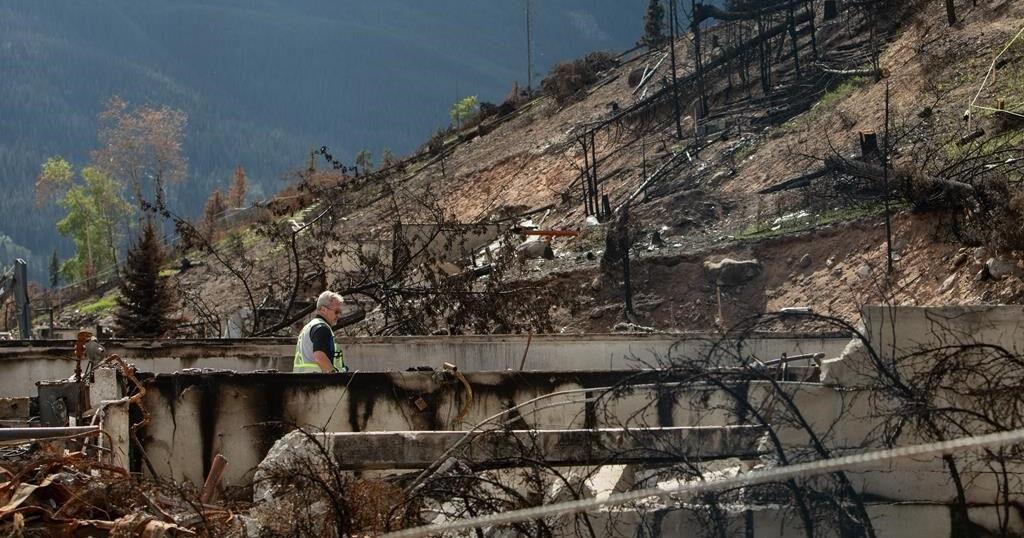The road to recovery is starting to clear for businesses in Jasper, Alta., a month after some 25,000 visitors and residents were forced to flee a raging wildfire.
While Jasper National Park and the town are still closed to visitors, on Friday the park service announced that it had reopened the road south through the Rocky Mountains that is a key draw for tourists.
“Getting the Icefield Parkway Highway 93 open all the way between Jasper, Lake Louise and Banff was really important,” said Paul Hardy, owner of SunDog Transportation and Tour Co.
The route adds to the full reopening of Highway 16 earlier this week, which has ushered in teams of service workers to help rebuild the community, bringing businesses closer to reopening.
SunDog restarted its shuttle route from Edmonton to Jasper on Friday as well, though for now it’s just for residents and workers, said Hardy.
“As far as our company goes, that’s a big milestone in terms of the rebuild and the restart.”
There are signs of reopening in town, too. The grocery store, pharmacy and gas stations were open to welcome residents who started returning a week ago, while the Crazy Elk Cafe also opened for residents on Friday, said Hardy.
“It’s a good sign…I really do feel optimistic about both the near term, and certainly the longer term.”
Supports for businesses are also starting to take shape.
Community Futures West Yellowhead, which provides business coaching and entrepreneurial support to the region, is launching a $5,000 to $15,000 low-interest loan program to help tide businesses over, said general manager Nancy Robbins.
The organization, funded by Prairies Economic Development Canada, has been busy helping small businesses as they handle their accounting, figure out payroll, insurance and the many other financial challenges they face on top of the personal toll of losing so much.
Robbins is closely aware of the devastation of the fire; her home is one of only four left on her street.
But now that residents have had time to take stock, they’re turning the focus to reopening, she said.
“We’ve seen a change now with re-entry that businesses are really feeling the need to reopen,” said Robbins.
“They want to get back to work, they want to open their businesses.”
Community Futures is working to understand just how big a toll the fire has taken on businesses, conducting a survey with the Red Cross and the Alberta government to get data that they can then turn into more supports.
An earlier survey conducted by the Tourism Industry Association of Alberta gave some sense of scale, estimating daily revenue losses as high as $4.5 million a day during the peak summer months.
The losses are on top of the property lost, which the town of Jasper said amounted to $283 million. That number doesn’t cover what was inside homes or vehicles and the many other insurance claims expected.
The survey found that 53 per cent of respondents wouldn’t survive more than two months without immediate support.
It also showed an urgent need for housing and staff accommodation support with more than half saying they’d need help.
SunDog Tours lost two staff houses in the fire along with its administrative building, just a few of the 358 structures making up about a third in town that were destroyed.
Some businesses expect to see a spike in business ahead as the rebuilding gets underway but are largely on hold for now.
Mairead Colbath and her husband run Colbath Design Ltd., an interior design company that also provides permitting services, a process that gets tricky when building in a national park.
The town and the park are still working out building codes and planning issues as they look to reduce future wildfire threats, so Colbath will have to wait until those decisions are made before ramping up.
“Business right now is at a standstill…we just have to wait and see and take it as it comes, you know, day by day.”
She said she expects they’ll be plenty busy in the future, but that for now there’s a lot of uncertainty in town with many people still coming to terms with the loss.
“It’s been very upsetting and emotional here for people. They’ve seen their dreams go up in smoke.”
And while there are signs of reopening, some businesses have already said they won’t be able to reopen in the near-term, a reminder of the toll the fire has taken on many operators.
Jasper Raft Tours, for one, said it will be closed for the remainder of the season.
“We have lost everything. We are devastated,” the company said in an emailed response.
However, they look forward to welcoming clients again in the future.
“I don’t know how and I don’t know when, but we will be back.”
This report by The Canadian Press was first published Aug. 23, 2024.
